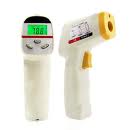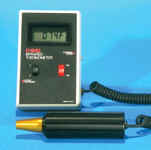|
Passive Infrared (PIR) Devices  A Passive InfraRed sensor (PIR sensor) is an electronic device that measures infrared radiation from objects in its field of view. All objects emit infrared radiation that is invisible to the human eye but can be detected by electronic devices designed for such a purpose. The term passive means that the PIR device does not emit an infrared beam but merely passively accepts incoming infrared radiation.
The PIR sensor is typically mounted on a printed circuit board (PCB) containing the necessary electronics required to interpret the signals from a pyroelectric sensor chip. The sensor is mounted in a location where it can view the area to be monitored. Infrared energy is able to reach the pyroelectric sensor through the window because the plastic used is transparent to infrared radiation (but only translucent to visible light). This plastic sheet also prevents dust and/or insects from obscuring the sensor's field of view, and in the case of insects, from generating false alarms. The distant infrared energy needs to be focussed onto the sensor surface - the window may have multiple lenses molded into it (see the picture above) focussing the rays by refraction - or parabolic concave mirror segments may be used at the back of the housing to reflect the IR to a focus on the detector. Infra red thermometers
|
Follow me...
|


 PIR sensors are often used in the construction of PIR-based motion detectors - these are usually connected to intruder alarm systems. Motion is detected when an infrared source with one temperature, such as a human, passes in front of an infrared source with another temperature, such as a wall. The change of temperature of the object 'viewed' by the sensor means that it gets a change in infra red radiation (hotter objects emit higher frequency infra red than lower temperature ones). This change in radiation received triggers an output to the alarm system.
PIR sensors are often used in the construction of PIR-based motion detectors - these are usually connected to intruder alarm systems. Motion is detected when an infrared source with one temperature, such as a human, passes in front of an infrared source with another temperature, such as a wall. The change of temperature of the object 'viewed' by the sensor means that it gets a change in infra red radiation (hotter objects emit higher frequency infra red than lower temperature ones). This change in radiation received triggers an output to the alarm system.
 These are useful to measure body temperature in a safe non-invasive way or inindustry to measure the temperature of objects removed from an oven - to monitor how hot they are. In some industrial processes layers have to be applied on top of another layer when it has cooled a certain amount. These thermometers can accurately tell the temperature of the cooling surface without needing to have contact with it.
These are useful to measure body temperature in a safe non-invasive way or inindustry to measure the temperature of objects removed from an oven - to monitor how hot they are. In some industrial processes layers have to be applied on top of another layer when it has cooled a certain amount. These thermometers can accurately tell the temperature of the cooling surface without needing to have contact with it. 


